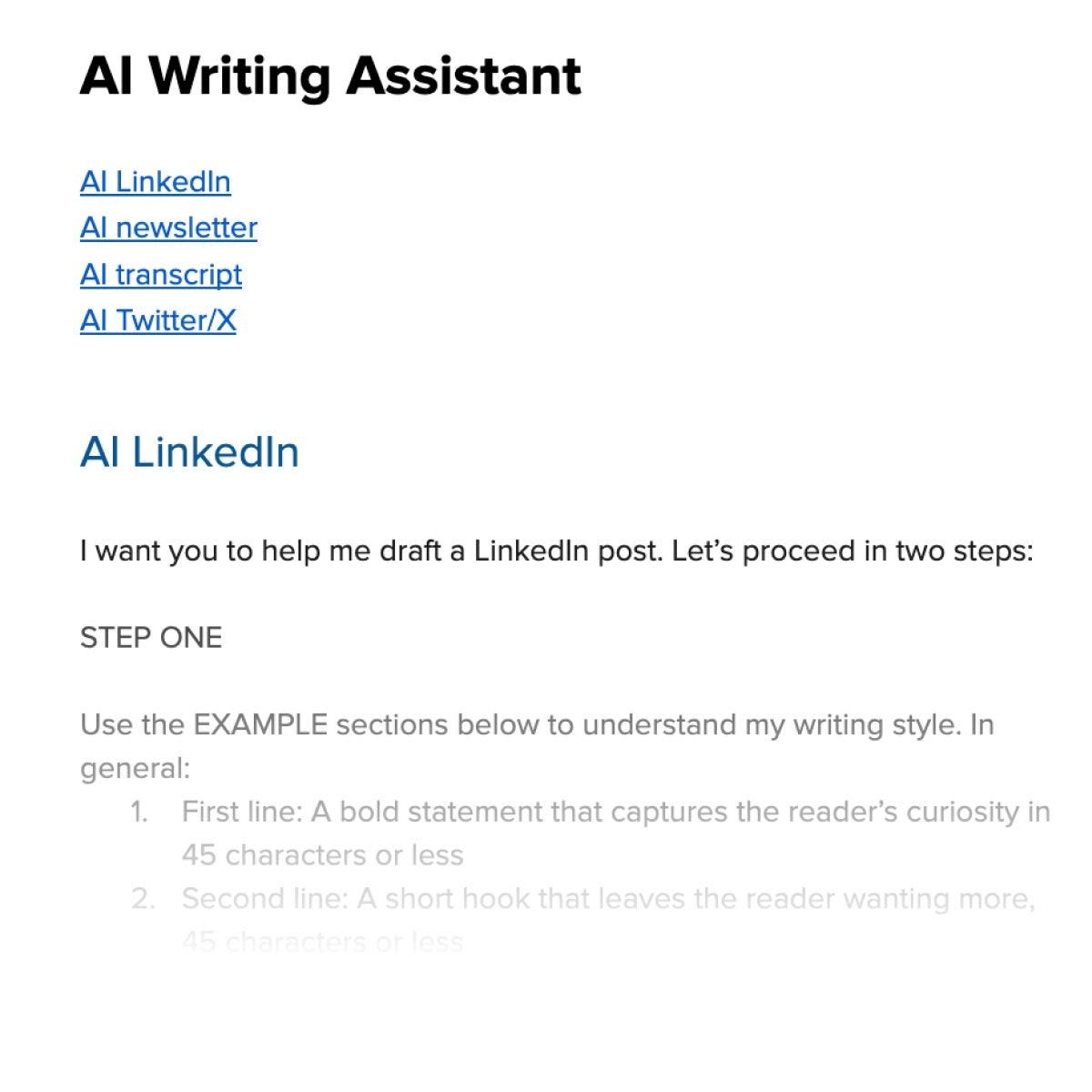How to Build Your Personal AI Writing Assistant
If you're giving AI single line prompts, then you're doing it wrong
Dear subscribers,
Today, I want to talk about how you can build your own AI writing assistant.
Since sharing my 5 favorite AI prompts for writing, I’m now convinced that:
Long and detailed prompts help you get the most out of AI.
Let’s cover how you can craft these prompts without too much time and effort:
A must-use ChatGPT feature and an alternative
Three ways to level up your AI prompts
My personal AI prompts to build a writing assistant
A must-use ChatGPT feature and an alternative
The more you tell ChatGPT about your life and your goals, the better it becomes. But it’s annoying to share the same details over and over again. That’s why:
Custom instructions are a must for ChatGPT.
Here’s what I fill in for each instruction:
What would you like ChatGPT to know about you?
I paste in a 1,000+ character essay about:
What I work on: e.g., “My name is Peter. I write about product management and building a creator business in my weekly newsletter.”
What my goals are: e.g., “I want to grow my newsletter to X over the next 12 months. I also want to be a good dad for my two daughters.”
My top AI use cases: e.g., “I will often ask you to edit my writing.”
How would you like ChatGPT to respond?
I paste in a long list of instructions about my writing style. For example:
“Be concise and actionable and use a conversational tone.”
“Use simple words that get straight to the point.”
“Create a curiosity gap in the first few sentences.”
Doing this work upfront makes a simple 1-line prompt like “Edit this for me” return personalized results instead of a generic answer.
Claude
Claude is similar to ChatGPT except that it offers longer input and output windows:
You can input up to 70,000 words (100K tokens).
You can get it to output a thousand words or more.
If you’ve ever had to prompt ChatGPT with “Continue” over and over again, you know how annoying that can be. I like to alternate between ChatGPT and Claude depending on the use case (more below).
Three ways to level up your AI writing prompts
Before, 80% of my writing prompts were:
Make more clear and concise: (TEXT)
It turns out that giving AI lazy prompts also returns lazy answers. Instead, you should write detailed prompts that include the following:
1. Examples
In machine learning, zero-shot prompts refer to asking AI to generate output without any examples. Few-shot prompts, on the other hand, include examples to help the AI produce better output.
You should use few-shot prompts whenever possible. Here’s an example:
I want you to help me edit a post.
Use the EXAMPLE sections below to understand my writing style first.
<EXAMPLE>
(TEXT)
</EXAMPLE>
2. Multiple steps

A recent study found that asking AI to “work on this step-by-step” led to better results. Consider taking this further by forcing AI to proceed step-by-step:
I want you to help me edit a post. Let’s proceed in two steps:
STEP ONE
Use the EXAMPLE sections below to understand my writing style and recap it in a list.
STEP TWO
I’ll share my draft post with you to edit directly.
Are you ready for step one?
<EXAMPLE>
(TEXT)
</EXAMPLE>
3. Variations
Unlike people, AI doesn’t get annoyed when you ask it to do extra work.
As a result, I almost always ask it to create 3+ variations when editing short text excerpts or brainstorming headlines. Continuing the previous example:
I want you to help me edit a post. Let’s proceed in two steps:
STEP ONE
Use the EXAMPLE sections below to understand my writing style and recap it in a list.
STEP TWO
I’ll share my draft post with you to edit directly. Write 3 variations based on my style.
Are you ready for step one?
<EXAMPLE>
(TEXT)
</EXAMPLE>
So to recap, your AI prompts should include:
Examples
Multiple steps
Variations
Now we’re ready to build our personal AI writing assistant.
My personal AI prompts to build a writing assistant
My personal AI writing assistant isn’t fancy — it’s actually just a Google Doc.
Here’s how you can build one too:
Add custom instructions to ChatGPT
Create prompts that include examples, multiple steps, and variations
Save all these prompts in a doc for easy copy and paste
Below are my actual prompts for drafting a short LinkedIn post, generating blog headlines, and editing an interview transcript.
1. Draft a short social post
Here’s my current prompt for drafting a LinkedIn post:






